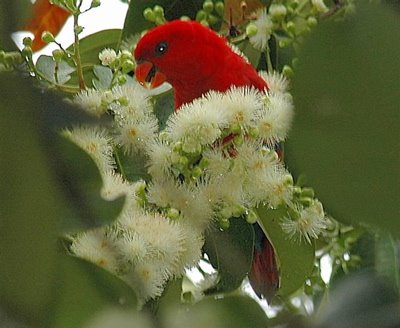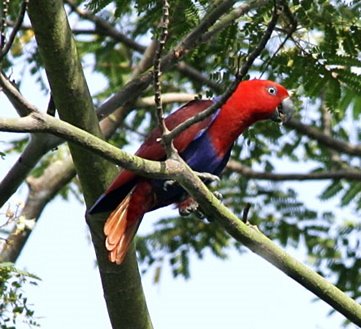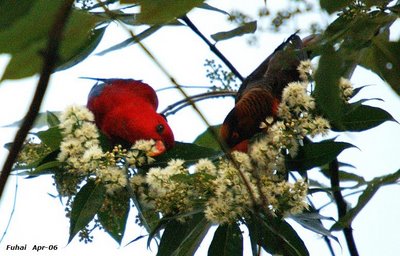Exotic red parrots
There seem to be quite a few species of exotic red parrots roaming the urban areas of Singapore, as seen from the images sent in to the various e-loops.
 In March 2006 Johnny Wee sent in an image (above) with a note stating that the red parrot was seen eating the fruits of the sea apple (Syzygium grande). Our bird specialist R. Subaraj has this to say: "The parrot in the photo is a lory. It is possibly a Red Lory (Eos bornea), though this cannot be confirmed definitely as the photo does not show the wings and most of the body, and the blue eye patch is difficult to see in the photo. The Red Lory is native to the Moluccas but is a regular escapee here, though it has not established itself as a feral species yet."
In March 2006 Johnny Wee sent in an image (above) with a note stating that the red parrot was seen eating the fruits of the sea apple (Syzygium grande). Our bird specialist R. Subaraj has this to say: "The parrot in the photo is a lory. It is possibly a Red Lory (Eos bornea), though this cannot be confirmed definitely as the photo does not show the wings and most of the body, and the blue eye patch is difficult to see in the photo. The Red Lory is native to the Moluccas but is a regular escapee here, though it has not established itself as a feral species yet."  Melinda Chan also sent in an image of a red parrot (above) and Subaraj has this to say: "This is a female Eclectus Parrot (Eclectus roratus). The male is green. It is an escapee, being native to northern Australia, New Guinea and the Moluccan islands of Indonesia. There are several past records of such escaped parrots around Singapore as the bird is regularly traded, but it has never become established."
Melinda Chan also sent in an image of a red parrot (above) and Subaraj has this to say: "This is a female Eclectus Parrot (Eclectus roratus). The male is green. It is an escapee, being native to northern Australia, New Guinea and the Moluccan islands of Indonesia. There are several past records of such escaped parrots around Singapore as the bird is regularly traded, but it has never become established." These are actually parrots of the rainforest canopy in their native countries. The feed on fruits, seeds and blossoms. They are noisy and conspicuous, because of the bright plumage. The remarkable sexual dimorphism has caused endless confusion to birders.
 Then Fuhai Heng sent in another image (above) with a note saying: "When we travel overseas, we feel glad when meeting someone from our own country. I noticed it is the same for escapee birds in Singapore. These birds gather for breakfast regularly at the Ang Mo Kio area to feast on the nectar from the flowers of the salam tree (Syzygium polyanthum) tree. They arrive at 7 am and leave half an hour later at the cue of one leader."
Then Fuhai Heng sent in another image (above) with a note saying: "When we travel overseas, we feel glad when meeting someone from our own country. I noticed it is the same for escapee birds in Singapore. These birds gather for breakfast regularly at the Ang Mo Kio area to feast on the nectar from the flowers of the salam tree (Syzygium polyanthum) tree. They arrive at 7 am and leave half an hour later at the cue of one leader."Subaraj has this to say: "Actually, this isn't a Rainbow Lory at all. It is one of the Eos lories of Wallacea, Indonesia. It is possibly the Violet-necked Lory (Eos squamata) of the North Moluccas.
"Apart from the Rainbows, there have been red lories flying around various parts of Singapore for a number of years now. Most of the time, we are unable to identify the species in flight but careful observation when perched or even better, a photo, will show us just how many different members of this genus and the Lorius genus free-fly here.
"Most of these parrots are protected by international and Indonesian laws but enforcement in most of Indonesia is weak or non-existent. As a result, large numbers of these beautiful parrots are smuggled out each year and many move through Singapore, as the constant escapees prove. Many can also be readily found available at pet shops here.
"None of these lories have established themselves as feral species in Singapore....yet! The Rainbow is the closest to doing so, with one reported breeding record. It would be good to continue monitoring them and report numbers as well as produce photos for identification of species."
Thank you Johnny Wee, Melinda Chan and Fuhai Heng for your input. Images by Johnny (top), Melinda (middle) and Fuhai (bottom).
Labels: Exotics



11 Comments:
Fuhai's Lory is feeding on a Syzygium sp. too - Syzygium polyanthum, the Salam Tree.
Considering your comment above, I am inclined to think that the tree Fuhai's lory is feeding is more likely to be a salam than an eucalyptus. I have made the necessary change. Thanks, anon.
The 1st pic is the red lory (eos bornea).This can be confirmed as the otehr species of this genus has some form of markings at the neack and head.It is the only species of Eos that has a "clean" red feather from head down to the wing. The other lory species which includes chalcopsitta,lorius,charmosyna,trichoglossus all have some form of obvious markings on the head and eye-rings.The 3rd pic shows the Red Lory (Eos bornea) and Dusky Lory (Pseudos fuscata) both natives to Indonesian Islands.There is the red dusky lory and the yellow dusky.This one could be the red variety.These birds are traded by the hundreds in Singapore.They are specialised nectar feeder so they have a brush-like papillae on the tongue to aid easy extraction of nectar from flowers.The papillae will be erected when feeding.
Usually kept as pets, these lories are rather messy eaters.So many avoid giving liquid food.Most are unfortunately fed with sunflower seeds and the conventional lory pellets.They are easy to breed and tame.Can be noisy like most parrots.They have established a colony here.A few are seen around the Mandai area and Botanical Gardens.These are a mixture of Rainbow Lories (Trichoglossus spp.),Eos spp (red,blue earred,violet necked,blue-streaked lories) and the pseudos sp (dusky lory) this si my 1st time seeing a "wild" dusky lory in SG.
Fantastic pictures guys.Its good for indentification purposes.
Cheers
a parrot enthusiast
I have a question.When is a species confirmed have colonised a speficif area?when they have bred or when the population hits a certain number?I have seen these parrots flying around SG for a long time.Have they not establish themselves yet?
Cheers
a parrot enthusiast
Thanks for a the valuable information.
I have referred the question about the status of escapees to our bird specialist and his reply:
"I believe that we have covered the requirements in a previous blog article or was it just during discussion. Anyway, all non-native species that are free-flying in Singapore, due to their escaping from a cage, being set free or being allowed to be
free-ranging within one of our wildlife attractions, are considered Escapees.
"For an Escapee species to be accepted as a Feral Species and be included into the national checklist as an Introduced (I) species, there are 3 criteria to be fulfilled. Firstly, that the species has been free-flying in Singapore for at least 10 years; Secondly, that the species has a self-sustaining population; Thirdly, that there is a successful breeding record. This is, more-or-less, the accepted norm in most countries.
:With regards to the various species of lorikeets/lories around Singapore, the Rainbow Lorikeet and perhaps the Red Lory have been free-flying for many years now, around the Botanic Gardens, MacRitchie and a couple of other areas. They certainly fulfill the first and second criteria but have never really exploded in numbers and lacked a breeding record.
"Last year, a successful breeding record for the Rainbow Lorikeet was finally confirmed in the west coast and the species has been added to the checklist.
"The others are still mere escapees and given the long lifespan for parrots, we cannot be sure that any breeding has occured until we document a successful nesting record."
Sorry, forgot to mention that our bird specialist is no other than R. Subaraj.
Thanks Sub.really appreciate your input.I will make it a point to monitor some of these birds wen i come across any nesting pairs.Thaks to YC too for forwarding it.Fantastic blog!
Cheers
A parrot enthusiast
Please add these photos to: http://www.flickr.com/groups/cityparrots/
We really like to learn more about the feral/naturalized parrots of singepore (but also the native ones).
Cheers,
Roelant
www.cityparrots.org
Hi Roelant. I can get permission from the photographers and send you the images if you could give me your e-mail address.
This comment has been removed by the author.
Post a Comment
<< Home